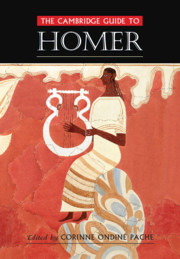Book contents
- The Cambridge Guide to Homer
- The Cambridge Guide to Homer
- Copyright page
- Contents
- Figures
- Notes on the Contributors
- General Introduction
- Part I Homeric Song and Text
- Part II Homeric World
- Part III Homer in the World
- Introduction
- Homer in Antiquity
- Homer and the Latin West in the Middle Ages
- Homer in Greece from the End of Antiquity 1: The Byzantine Reception of Homer and His Export to Other Cultures
- Homer in Greece from the End of Antiquity 2: Homer after Byzantium, from the Early Ottoman Period to the Age of Nationalisms
- Homer in Renaissance Europe (1488‒1649)
- Homer in Early Modern Europe
- The Reception of Homer since 1900
- Homer: Image and Cult
- Key Topics
- Bibliography
- Index
- References
Homer in Greece from the End of Antiquity 1: The Byzantine Reception of Homer and His Export to Other Cultures
from Part III - Homer in the World
Published online by Cambridge University Press: 22 February 2020
- The Cambridge Guide to Homer
- The Cambridge Guide to Homer
- Copyright page
- Contents
- Figures
- Notes on the Contributors
- General Introduction
- Part I Homeric Song and Text
- Part II Homeric World
- Part III Homer in the World
- Introduction
- Homer in Antiquity
- Homer and the Latin West in the Middle Ages
- Homer in Greece from the End of Antiquity 1: The Byzantine Reception of Homer and His Export to Other Cultures
- Homer in Greece from the End of Antiquity 2: Homer after Byzantium, from the Early Ottoman Period to the Age of Nationalisms
- Homer in Renaissance Europe (1488‒1649)
- Homer in Early Modern Europe
- The Reception of Homer since 1900
- Homer: Image and Cult
- Key Topics
- Bibliography
- Index
- References
Summary
This article traces the literary genres through which knowledge of Homer was communicated throughout the Byzantine period. Centos were a vehicle through which the taste for Homerizing diction and versification were diffused. Likewise, texts in languages that closely engaged with the grammar and rhetorical structure of Greek (Syriac, Georgian) indicate acquaintance with those verses of Homer that were frequently used in Greek as grammatical and rhetorical examples. Varying degrees of acquaintance with Homeric plots and heroes are evident in several medieval literatures (Latin and various Western European vernaculars, but also Syriac, Arabic, Armenian, Georgian, Slavic). The richest path for such diffusion of Homeric knowledge is found in translations of world chronicles, where Homer’s royal figures regularly appear as part of a universal history of kingship. In addition, allegorical readings of Homeric stories (equating Homeric figures with cosmic elements or qualities of the human soul) were widely diffused in philosophy and the natural sciences.
- Type
- Chapter
- Information
- The Cambridge Guide to Homer , pp. 444 - 472Publisher: Cambridge University PressPrint publication year: 2020

